Isabela Island 10 Best Things to Do in the Galápagos
Last updated on May 24th, 2025 at 04:16 pm
My boots hit the volcanic sand at Isabela’s tiny airport, and I knew something was different. The air smelled like nowhere else I’d been salty ocean mixed with this earthy, almost metallic scent from the black rocks everywhere.
Carlos, my local guide, grabbed my backpack and chuckled at my wide-eyed expression. “First time on Isabela?” When I nodded, he just said, “You’re in for it now.”
That was March 2023, and honestly? I thought I had the Galápagos figured out already. I’d spent three days on Santa Cruz playing tourist – taking photos of giant tortoises, watching blue-footed boobies do their silly dance. Standard stuff, you know?
But Isabela? This place flipped everything upside down.
By sunset that first day, I’d swum next to actual penguins. Not in Antarctica – right here at the equator. The next morning, I hiked across the rim of an active volcano while watching flamingos feed in lagoons that looked like they belonged on another planet entirely.
If you’re heading to the Galápagos and thinking about skipping Isabela to save time or money, stop right there. Here’s why this island needs to be your number one priority, plus the ten experiences that’ll blow your mind just like they did mine.
Table of Contents
Why Isabela Island Beats Every Other Galápagos Destination
Let’s start with the basics. Isabela is massive – over half the land in the entire Galápagos sits right here. But here’s what nobody tells you: despite being the biggest island, it feels empty compared to the zoo-like crowds on Santa Cruz.
Six volcanoes built this place, and five are still rumbling. You’re literally walking on brand-new Earth. The youngest parts of this island formed just decades ago. That’s insane when you really think about it.
What really got me was the variety. One minute you’re on white sand beaches, the next you’re hiking across black lava fields that look like the moon. Then you’re underwater with tropical fish, penguins, and sea lions all in the same afternoon.
The numbers that matter:
- Covers 2,900 square miles (bigger than Delaware!)
- Home to about 2,200 people
- Five active volcanoes still shaping the landscape
- Way fewer tourists than the “main” islands
Swimming with Penguins at Las Tintoreras (Yes, Really)
Picture this: I’m floating in water so clear I can see my fins 20 feet below, when this black and white torpedo zooms past my mask. My brain went, “Wait… was that actually a penguin?”
It was. And it came back with friends.
Las Tintoreras is this cluster of tiny islands connected by old lava bridges, and it’s the only spot on Earth where you can snorkel with penguins at the equator. These little Galápagos penguins are maybe two feet tall, but underwater they move like rockets.
The whole setup is perfect for beginners too. The water stays calm because these islets block the waves. White-tip sharks cruise around, but they’re basically oversized puppies – they spend most of their time napping on the sandy bottom.
What made it special for me:
- Those tiny penguins that zip around like underwater bullets
- Marine iguanas sunbathing on black rocks like prehistoric dragons
- Sea lions that swim right up to check you out
- Water so clear you can see everything, even without a mask
Best time to go? Early morning around 7 AM when everything’s still waking up. Most tours include gear, but bring your own mask if you’ve got one. Trust me, the fit makes all the difference when you’re trying to film a penguin doing barrel rolls.
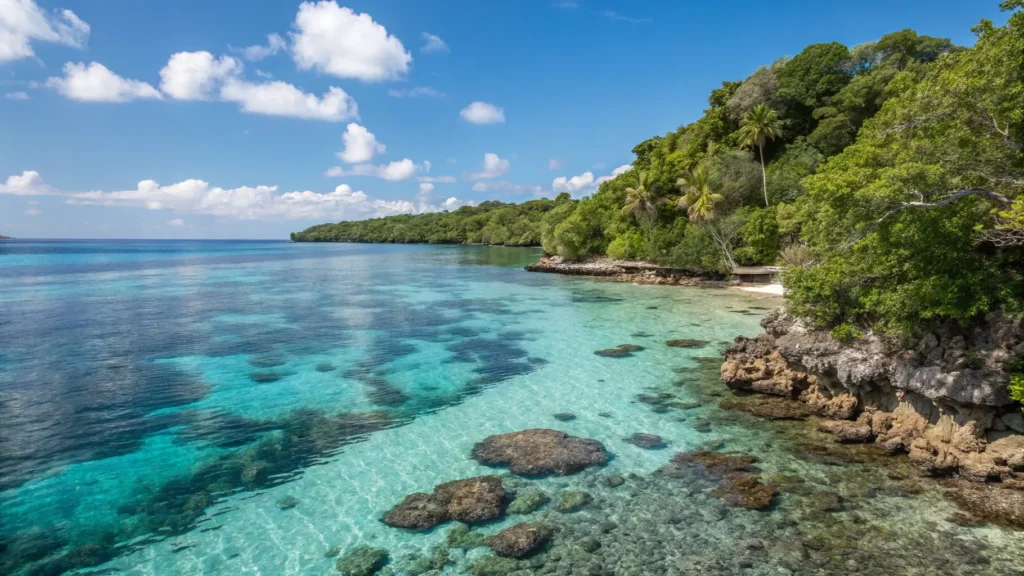

Pro tip from my mistakes: Don’t chase the wildlife. Just float there like a log, and they’ll come investigate you instead.
Hiking Sierra Negra Volcano My Legs Hated Me, But My Eyes Loved It
A year ago, if you’d told me I’d hike 10 miles across volcanic rocks in blazing heat, I’d have laughed in your face. But standing on Sierra Negra’s rim, staring into a crater six miles across, every blister on my feet was worth it.
This crater is the second-biggest in the world. The whole thing erupted just six years ago, and you can still see where fresh lava flowed down the mountainsides.
The hike starts easy enough – you’re basically walking across this alien landscape of hardened lava with weird plants growing in the cracks. But when you hit that crater rim? Game over. The view just goes on forever.
What the hike’s really like:
- 10 miles total, but mostly flat
- Takes about 6-8 hours with transport
- Moderate difficulty (I’m no athlete and survived)
- Best started early to beat the afternoon heat
Here’s what nobody warns you about: bring way more water than makes sense. I packed two full bottles and finished both before reaching the crater. The sun bounces off all that black rock and hits you from every direction.
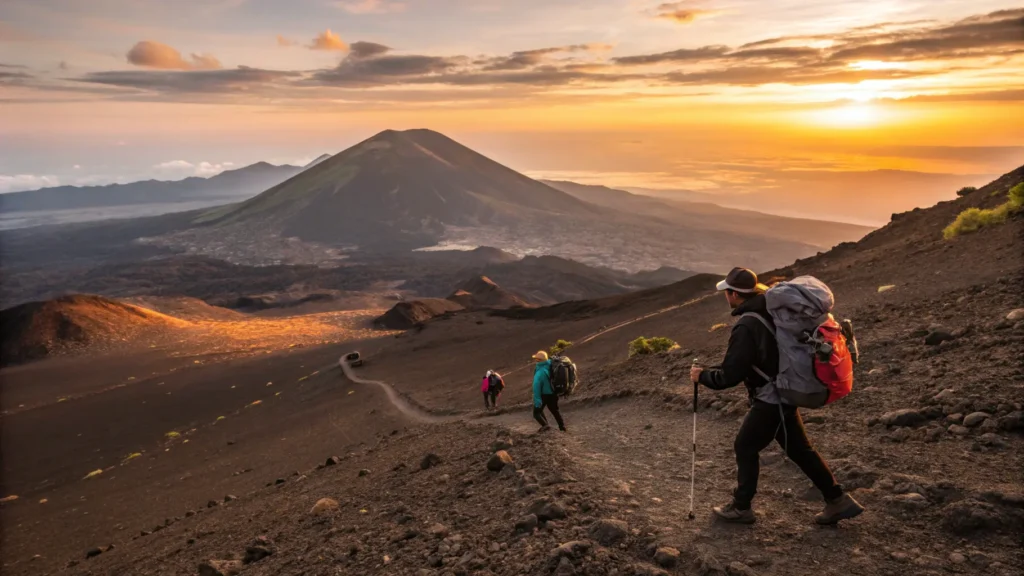

If you’ve still got energy at the rim (most people do), the side trip to Volcán Chico is incredible. Fresh lava formations, sulfur vents still releasing gas – it’s like visiting another planet that happens to have oxygen.
Meeting Ancient Giants at the Tortoise Breeding Center
Standing next to a 500-pound tortoise that’s older than your grandparents puts life in perspective real quick. The Arnaldo Tupiza Breeding Center isn’t just a tourist stop – these folks are literally saving species from disappearing forever.
They’ve got five different types of giant tortoises here, each one evolved for different parts of the island. Some have dome shells, others have saddle-shaped ones that let them reach higher plants. Evolution happening right in front of you.
The baby tortoises are ridiculously cute. They’re about the size of dinner plates and move around like little tanks. But the big guys? They’re surprisingly fast when they want something. I watched one lumber toward a pile of cactus faster than I walk to get coffee in the morning.
What hit me hardest:
- Seeing babies next to 150-year-old giants
- Learning some populations dropped to just 15 individuals in the 1970s
- Watching these massive creatures munch cactus like it’s candy
- Understanding how close we came to losing them forever
Visit mid-morning when they’re most active and eating. The conservation story here is incredible – species brought back from 15 individuals to stable populations through programs like this one.
Finding Flamingos in Volcanic Paradise
I’ll level with you – I wasn’t expecting much from some pink birds standing around. Boy, was I wrong about that too.
The Galápagos flamingos aren’t your regular zoo flamingos. There are maybe 400 in the entire island chain, making them rarer than giant tortoises. Watching them feed in these bizarre volcanic lagoons felt like discovering unicorns.
These lagoons formed from volcanic activity and filled with brackish water loaded with tiny organisms that flamingos love. The more they eat, the pinker they get – nature’s own filter system.
Why these flamingos are different:
- Only a few hundred exist in the wild
- They’re filter feeders (who knew?)
- Turn their heads upside down to eat
- Get pinker from their diet
- Live in lagoons that look like Mars
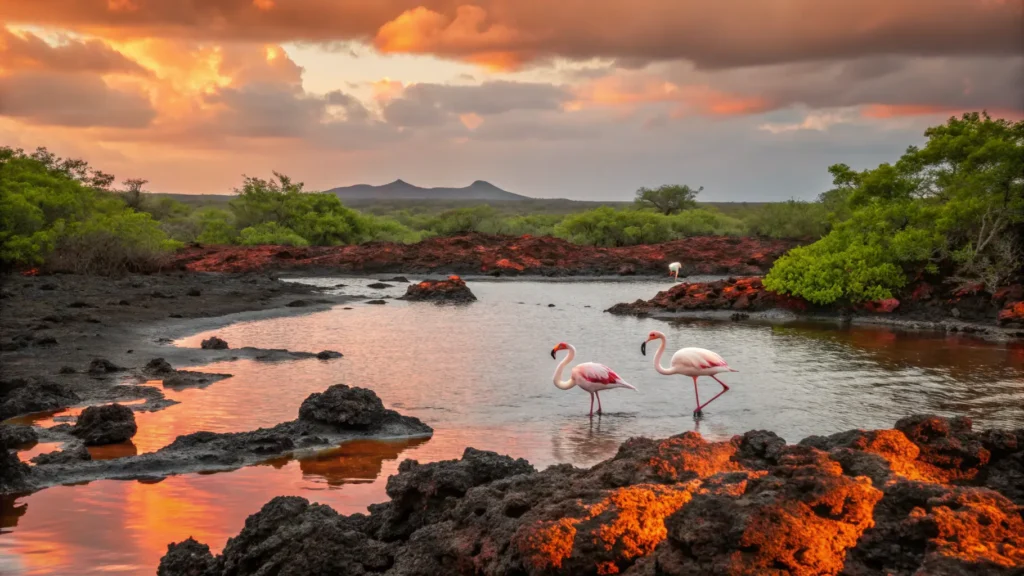

Best viewing happens during breeding season from December through May. Bring binoculars because you need to keep your distance. Early morning or late afternoon gives the best light for photos.
Stepping Back in Time at Tagus Cove
Tagus Cove feels like a history book carved into rock. The cliffs here are covered with graffiti from 1800s whalers and pirates who used this sheltered bay as their hideout. Some inscriptions go back to the 1830s – before Darwin even showed up.
But the real magic happens underwater. I saw green sea turtles, eagle rays, and more tropical fish than I could count. The water usually stays calm and clear, perfect for underwater photos.
The boat ride around the cove is half the adventure. Our captain pointed out sea lions lounging on ledges and told stories about how this bay sheltered ships during storms. All that maritime history happened right where we were floating.
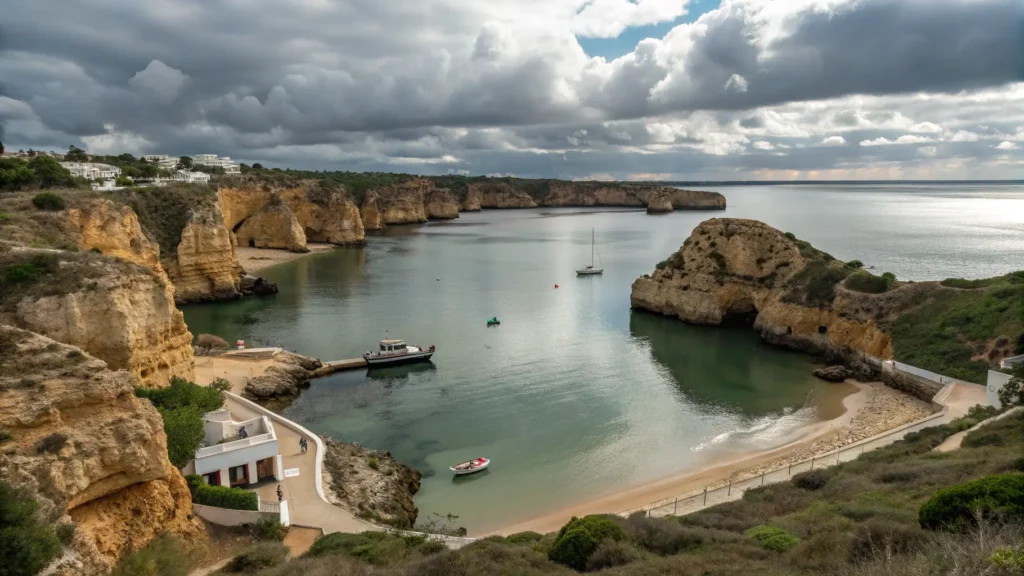

What makes it worth your time:
- Graffiti from actual pirates and whalers
- Calm, clear water perfect for snorkeling
- Dramatic boat rides along towering cliffs
- Land iguanas hanging out on shore
- Stories that bring history to life
Beach Therapy at Puerto Villamil
After all that hiking and swimming, your body’s going to demand some serious beach time. Puerto Villamil delivers with some of the most beautiful beaches I’ve seen anywhere.
Playa del Amor became my evening ritual spot. White sand, perfect for sunset watching, with a little beach bar that serves cold beer for about three bucks. I spent my last night on Isabela right here, watching the sky turn every shade of orange and pink you can imagine.
Playa de los Alemanes is quieter if you want to escape even the tiny crowds. Softer sand, and depending on timing, you might have the whole stretch to yourself.
Beach activities that saved my sanity:
- Sunset watching with cheap beer
- Kayaking through nearby mangroves
- Beach volleyball with locals
- Fresh seafood at colorful beachfront restaurants
- Just lying there doing absolutely nothing
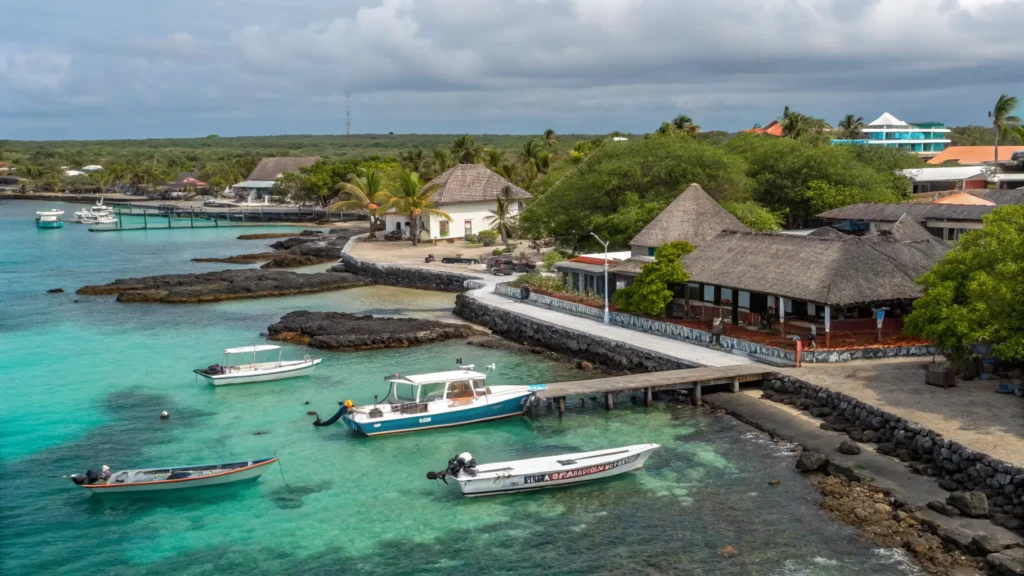

The town itself is painted in bright colors, and everyone seems to know everyone else. It’s the kind of place where you end up staying longer than planned because leaving feels wrong.
Paddling Through Mangrove Secrets
I’ve kayaked plenty of places, but gliding silently through Isabela’s mangrove forests felt completely different. These aren’t just pretty waterways – they’re nurseries where marine life grows up before heading to the open ocean.
Concha de Perla is the popular spot for good reason. The water’s incredibly clear, and you can often see rays and small sharks right from your kayak. Don’t worry – they’re harmless and way more scared of you.
Why kayaking here beats boat tours:
- No engine noise scaring wildlife away
- Get close to marine life without disturbing them
- Learn about mangrove ecosystems from water level
- Great workout that doesn’t feel like exercise
- Perfect for beginners and experts alike
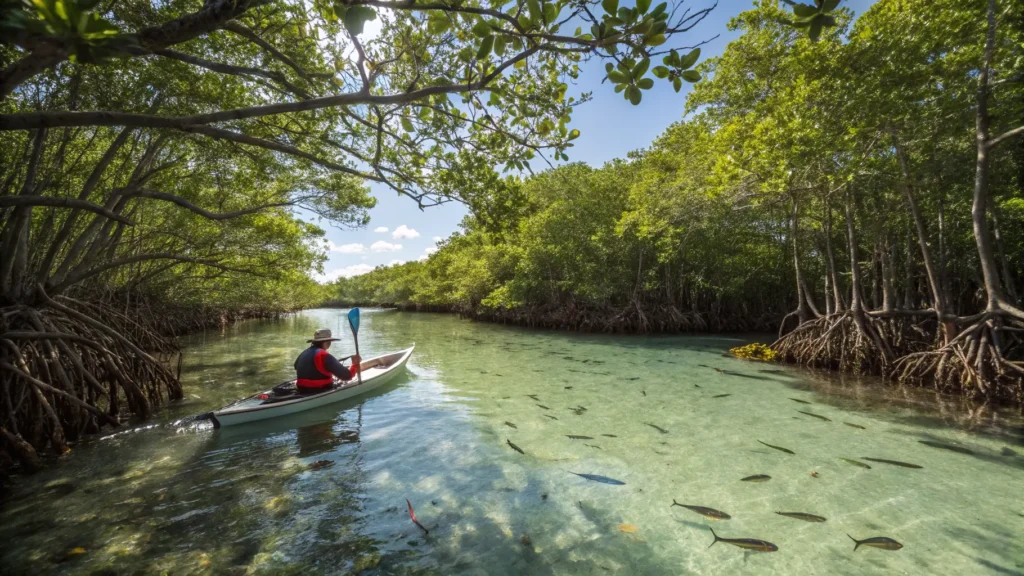

The silence is what gets you. No crowds, no engines – just you, the water, and whatever decides to surface nearby. A sea turtle popped up five feet from my kayak, and we just stared at each other for a moment before it dove back down.
Confronting History at the Wall of Tears
The Wall of Tears hits different than the rest of Isabela. From 1944 to 1959, this island hosted a brutal penal colony where prisoners built this massive wall from volcanic stones – for absolutely no purpose except punishment.
The bike ride from town takes about 45 minutes and gives you time to think about the contrast between natural beauty and human cruelty. Many prisoners died building this wall, and you feel that weight when you stand in front of it.
What to expect:
- 45-minute bike ride or 2-hour walk from town
- Information plaques explaining the history
- Views of the landscape prisoners saw daily
- Time to reflect on how places can transform
- Usually combined with other nearby stops
It’s heavy, but important. The transformation from punishment colony to conservation paradise shows how dramatically places can change direction.
Exploring Punta Moreno’s Alien Landscape
Want to see what Mars would look like with wildlife? Punta Moreno is your answer. This area is covered in pahoehoe lava – the smooth, ropy kind that hardens in incredible patterns.
What’s mind-blowing is how life thrives even here. Tide pools scattered through the lava are packed with colorful fish, crabs, and other marine creatures. Flightless cormorants nest in the rocks, and flamingos sometimes show up in nearby lagoons.
What makes Punta Moreno unique:
- Pahoehoe lava formations that look like art
- Tide pools bursting with marine life
- Flightless cormorants in their natural habitat
- Potential flamingo sightings
- Photography opportunities that look otherworldly
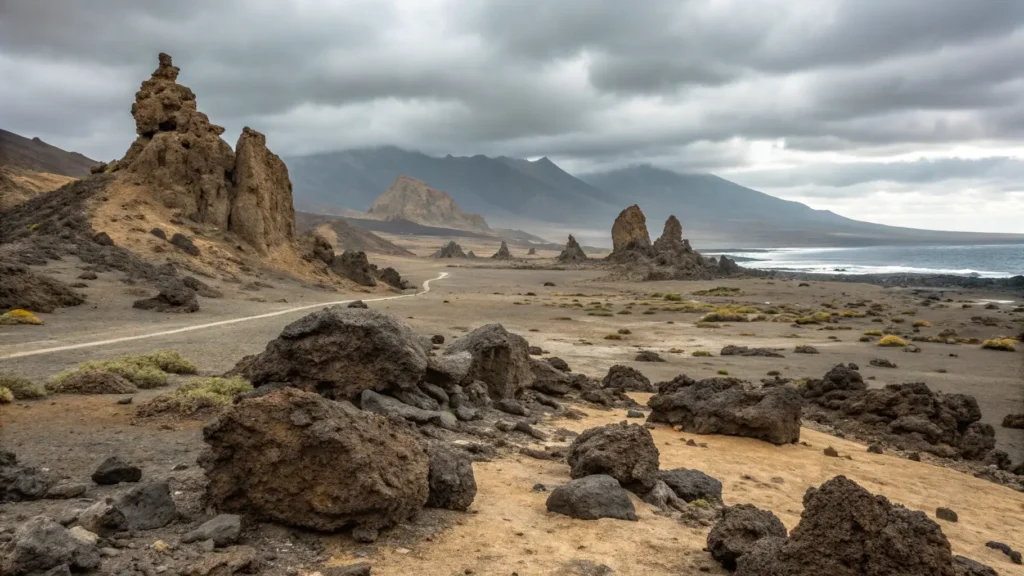

The contrast is stunning – black volcanic rock against turquoise water, with wildlife thriving in between. It really shows how life finds a way in the most unlikely places.
Discovering Elizabeth Bay’s Marine Sanctuary
Elizabeth Bay is only reachable by small boat, which immediately makes it feel special. This is one of the most pristine marine environments in the Galápagos, with mangrove channels serving as nurseries for countless species.
The boat ride through narrow channels is like being inside a nature documentary. Our guide observed pelican colonies, ray feeding grounds, and sea turtle nesting locations. Rays may be seen swimming beneath the boat because the water is so clean.
What sets Elizabeth Bay apart:
- Accessible only by small boat
- Pristine mangrove ecosystem
- Active sea turtle nesting sites
- Incredible ray spotting opportunities
- Strict protections keeping it wild
This is where you really see conservation in action. Elizabeth Bay is so protected you can’t even step on land – and the difference shows. Wildlife here is abundant and completely unafraid of humans.
Getting There and Getting Around
Alright, let’s talk practical stuff. Reaching Isabela takes more effort than the other islands, but it’s totally worth it.
Your transport options: Flying takes 30 minutes from Baltra and costs around $180 each way. Expensive, but saves tons of time. The ferry from Santa Cruz takes 2.5 hours for about $30, but can be rough if seas are choppy. I took the ferry there and flew back – my stomach appreciated that choice.
Timing your visit: December through May brings warm weather with occasional rain, perfect for sea turtle nesting and flamingo breeding. June through November is cooler and drier, better for hiking but rougher for water activities.
Where to sleep: Puerto Villamil has options for every budget. I stayed at a mid-range place for $120 per night, but hostels start around $40 and luxury eco-lodges hit $300+. Book early – room options are limited.
What It Actually Costs
Let me be straight about money. The Galápagos isn’t budget travel, and Isabela follows that pattern. Here’s what I spent during four days:
- Hotel: $120 per night (mid-range with AC)
- Food: $60 per day (restaurants plus some street food)
- Activities: $150 per day average (varied by tour)
- Getting around: $50 per day (bikes, taxis, boats)
- Park fee: $100 (one-time entrance)
Four-day total: About $1,640
Sounds like a lot? Maybe. But you’re visiting one of the most unique places on Earth. Some experiences are worth splurging for.
Being a Good Visitor
Being a temporary custodian of something priceless is what it means to visit the Galápagos. The rules aren’t suggestions – they protect ecosystems that took millions of years to develop.
Non-negotiable guidelines:
- Stay 6 feet from all wildlife (no sea lion selfies!)
- Stick to marked trails always
- Never feed any animals
- Use only reef-safe sunscreen
- Pack out everything you bring
- Book only with certified guides
I watched tourists break these rules repeatedly, and it made me cringe every time. The wildlife here trusts humans because they’ve been protected. Let’s keep it that way.
Why Isabela Changed My Travel Perspective
Looking back, Isabela stands out as the highlight of my entire Galápagos trip. It’s where I felt most connected to the natural world and most amazed by what evolution can create.
Whether you’re floating with penguins, hiking across volcanic craters, or just watching sunset from a beach bar, Isabela offers experiences that exist nowhere else on Earth. It’s the kind of place that shifts your perspective on conservation, evolution, and our relationship with the natural world.
Planning a Galápagos trip? Make time for Isabela. Give it at least 3-4 days if you can swing it. You’ll leave with stories you’ll tell for decades and a deep appreciation for this incredible corner of our planet.
Your turn: Planning a Galápagos adventure? Already been? Drop a comment below – I’d love to hear about your experiences or help with any questions!


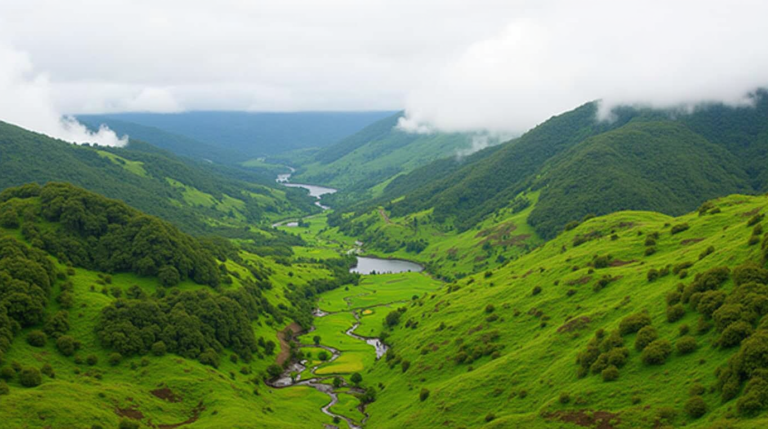


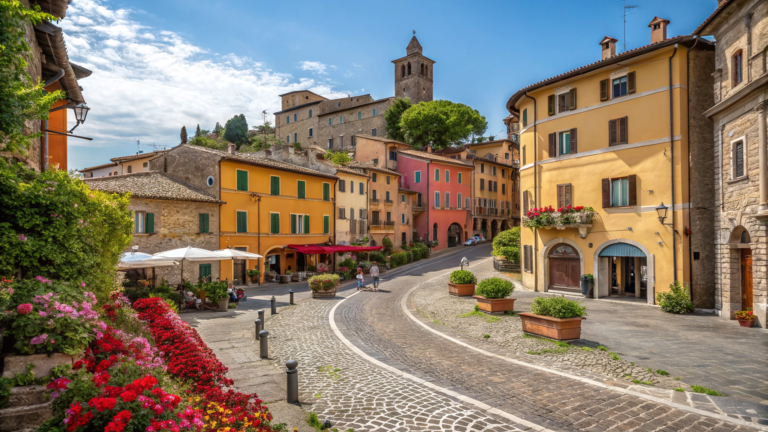
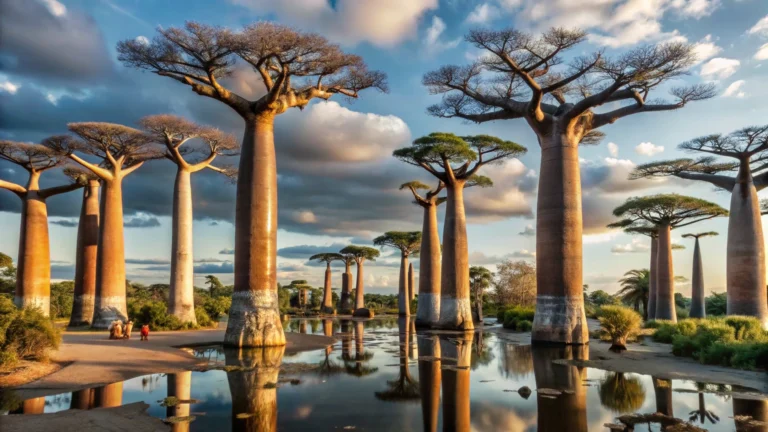
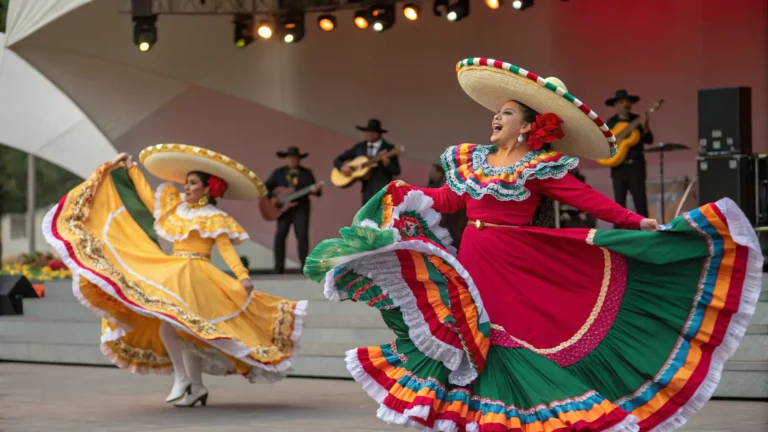
One Comment